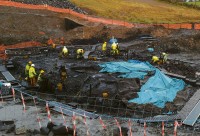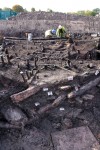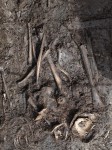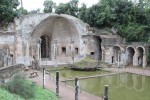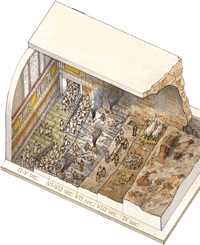I said in last year’s Year in History Blog History that I would attempt to make this a yearly tradition, so welcome to the second annual Year in History Blog History! Just a few days ago I was griping about the endless parade of crappy best-of lists so prevalent in the press between Christmas and New Year’s, but naturally I exempt myself from all such judgment and invite you to do the same.
The big news from behind the curtain this year was a marked leap in traffic. The total number of pageviews for 2012 was 1,647,856, more than double 2011’s tally which itself was more than double 2010’s views. Last year I noted that we passed a million pageviews in September as counted from when I installed the statistics plug-in in September of 2009. I mused restrainedly that given the uptick in traffic we might just reach the second million in time for this review, and in fact we’re less than 100,000 views from reaching 3,000,000.

January we crossed the 100,000 pageviews a month threshold and we haven’t looked back since. The lowest number of monthly views after January was July with 107,888. Stupid warm summer sun with the people out of doors grilling things and writing love letters in the sand and whatnot.
Nice weather didn’t stop people from flocking to the blog in May, though. That was our busiest month ever with a crazy 182,488 pageviews. Not coincidentally, the most viewed post of the year (and of all recorded time) was a May post. Hatfields & McCoys debuts on the History Channel, much to my surprise, turned out to be a record-breaker. It got 7,024 views on May 30th, driving that day’s pageviews to 13,135 and beating the previous daily record of 11,541 established in May (again!) of last year when there was that weird search explosion on the Roman Ship Found at Ostia entry.  It’s the most viewed post of the year, doubling the pageviews of the next runner-up, good ol’ reliable Michelangelo’s David.
It’s the most viewed post of the year, doubling the pageviews of the next runner-up, good ol’ reliable Michelangelo’s David.
The Hatfields and the McCoys also drew the most comments ever: 213 and counting, none of them mine. I had originally planned to respond to comments as they came in, something I try to do on general principle, but I didn’t want to say anything until I had seen the show. I didn’t get around to watching the programs I had DVRd until a week or so later and by then the comment thread was so towering I was too daunted to even attempt to scale it. I sure did enjoy reading it, though. The back and forth about the so-called bad language (which turned out to be of the “goddamn” variety rather than the naughty naughty bathroom words I had assumed the distressed commenters were talking about) was highly entertaining.
 It makes sense in hindsight because the show was a record-breaker for the History Channel as well, drawing more than 14 million viewers. The raging success of History’s first foray into scripted television trickled down to The History Blog and from there, I’m delighted to report, to website of Pike County, the county in Kentucky where many of the events of the infamous feud transpired. Jay Shepherd, Marketing Director of Pike County Tourism, had emailed me before I wrote the post asking if I’d link to their driving tour page in an entry about the Hatfields and McCoys. I did so and when the entry blew up, I could see the Pike County link was getting tons of hits. It turns out they got so many requests for the Hatfields and McCoys driving tour CD that they sold out! At the time they didn’t have the CD available on the website — people had to contact them via email or phone to order it — which makes the sale count even more impressive. He emailed me: “Our small little town really needs that extra push. So much history here.”
It makes sense in hindsight because the show was a record-breaker for the History Channel as well, drawing more than 14 million viewers. The raging success of History’s first foray into scripted television trickled down to The History Blog and from there, I’m delighted to report, to website of Pike County, the county in Kentucky where many of the events of the infamous feud transpired. Jay Shepherd, Marketing Director of Pike County Tourism, had emailed me before I wrote the post asking if I’d link to their driving tour page in an entry about the Hatfields and McCoys. I did so and when the entry blew up, I could see the Pike County link was getting tons of hits. It turns out they got so many requests for the Hatfields and McCoys driving tour CD that they sold out! At the time they didn’t have the CD available on the website — people had to contact them via email or phone to order it — which makes the sale count even more impressive. He emailed me: “Our small little town really needs that extra push. So much history here.”
Another post whose real world impact delighted me was my interview with Janet Stephens: Intrepid Hairdressing Archaeologist. Janet’s impressive scholarship and nimble fingers inspired many teachers, students and re-enactors. Neal Quillinan, a teacher at a secondary school in Australia, left a comment that made my day and possibly my year.
A fantastic post and a valuble resource. I used this in teaching my senior history girls about the First Triumvirate and the rise of Augustus. It was most engaging and its scholarly tone made it very much useable on their research assignment. You really struck a positive chord with this one…. one student event wore her hair in Agrippina style to her Senior Formal.
Agrippina prom hair! That totally slays me. I emailed Janet to let her know and she was thrilled to pieces, of course.
While I’m on the subject, be sure to subscribe to Janet’s YouTube channel. She’s been posting new videos regularly over the past few months, and they are each one more brilliant than the last. They all feature live models rather than manikins and one of them recreates the late 1st century A.D. orbis comarum style on a woman with short hair. It’s a must-see.
I don’t know if I can pick my single most favorite post of the year. There are several top contenders depending on the criteria, so instead of just nominating one, I’ll cull a few of my favorites in various categories.
 For sheer adrenaline-fueled excitement, nothing can beat the announcement that a skeleton of a male with scoliosis and a cleaved skull was discovered at the Grey Friars site in Leicester, the church where King Richard III was buried after he was killed at the Battle of Bosworth. It was my first liveblog and the first time I wrote a whole paragraph in “holy shit can you believe this” all caps. We’re still waiting for the DNA results that might confirm if this skeleton is that of the last Plantagenet king of England. I’ve read some interesting nuggets in the interim, but I’m saving them up for a post next year when we finally get the big news.
For sheer adrenaline-fueled excitement, nothing can beat the announcement that a skeleton of a male with scoliosis and a cleaved skull was discovered at the Grey Friars site in Leicester, the church where King Richard III was buried after he was killed at the Battle of Bosworth. It was my first liveblog and the first time I wrote a whole paragraph in “holy shit can you believe this” all caps. We’re still waiting for the DNA results that might confirm if this skeleton is that of the last Plantagenet king of England. I’ve read some interesting nuggets in the interim, but I’m saving them up for a post next year when we finally get the big news.
Other favorite finds I wrote about this year include Catherine de Medici’s hairpin found in palace toilet, the bed burial of the 7th century Anglo-Saxon teen girl with the beautiful gold and garnet cross, the new terracotta warriors from the mausoleum of emperor Qin Shi Huang which also gave me an opening to namecheck Firefly, the colossal statue of Neo-Hittite warrior king Suppiluliuma whose arms reminded me of Beavis freaking out because he’s never going to score, the 159 pristine Roman gold coins found near St. Albans that are so shiny and new, and the Etruscan pyramids found carved out of Orvieto caves which saw the lead archaeologist post a comment wherein he complimented me on not writing a bunch of vague, inaccurate hype like so many articles in the press had done. My head swelled three sizes that day.
 That’s not the only example of an entry where I feel like the mainstream articles either got things wrong or just didn’t focus on the parts I found interesting. My two favorites along those lines were my story about the Jesus Monkey restoration and the sale of the original Batmobile. Cecilia Giménez’s attempt to restore a fresco of Jesus originally painted by Elías García Martínez on the wall of a church in Borja, Spain, has become a full-fledged meme in its own right based solely on its hilarious awfulness. What gets left out, however, is how the original was a dashed off copy of a cheesy prayer card version of Guido Reni’s Head of Christ Crowned with Thorns, not a masterpiece for the ages. The other articles about the Batmobile left off most of the great details about the Lincoln Futura which from my perspective is totally the best part. Not that I’m putting down the greatest of all Batmobiles, mind you. As I said in the entry, I don’t know what I wouldn’t do to get my mitts on that car.
That’s not the only example of an entry where I feel like the mainstream articles either got things wrong or just didn’t focus on the parts I found interesting. My two favorites along those lines were my story about the Jesus Monkey restoration and the sale of the original Batmobile. Cecilia Giménez’s attempt to restore a fresco of Jesus originally painted by Elías García Martínez on the wall of a church in Borja, Spain, has become a full-fledged meme in its own right based solely on its hilarious awfulness. What gets left out, however, is how the original was a dashed off copy of a cheesy prayer card version of Guido Reni’s Head of Christ Crowned with Thorns, not a masterpiece for the ages. The other articles about the Batmobile left off most of the great details about the Lincoln Futura which from my perspective is totally the best part. Not that I’m putting down the greatest of all Batmobiles, mind you. As I said in the entry, I don’t know what I wouldn’t do to get my mitts on that car.
Other beauties that sold at auction this year which I would gladly shower with gold like they were the Danaë to my Zeus are the model of a guillotine made out of animal bones by a Napoleonic prisoner of war in England, the Beau Sancy diamond, the land indenture signed by Meriwether Lewis and William Clark, the only document signed by both men known to exist, the Chief Joseph war shirt which sold to the ubiquitous APC (anonymous private collector) rather than the museum where it belongs, the green velvet and gold saddlecloth used by Queen Elizabeth I on her official visit  to Bristol, the amber gameboard King Charles I took to the scaffold with him, Byron’s copy of Frankenstein, that gorgeous pristine Enigma machine and the original Fahrenheit thermometer which could also go in the “I did not know that” category because researching it explained so much about the oddities of the Fahrenheit scale.
to Bristol, the amber gameboard King Charles I took to the scaffold with him, Byron’s copy of Frankenstein, that gorgeous pristine Enigma machine and the original Fahrenheit thermometer which could also go in the “I did not know that” category because researching it explained so much about the oddities of the Fahrenheit scale.
I have a bunch of favorite pictures this year. National Geographic’s high definition pictures of the wreck of the Titanic blew my mind, as did the 15th century Pastrana tapestries in all their gloriously restored vibrancy. The picture of Jane’s Carousel in Brooklyn besieged by Sandy was so compelling it was basically the entire post. Worth a thousand words and all that.
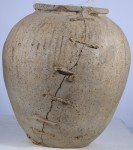 Pictures of two far more modest pieces that made me so happy, though, that they must be singled out. One was the Roman coarseware milk pot with the lead stitches. It’s so big and those stitches are just so damn cool. The other is the 15th century piggy bank from the Javanese Majapahit Empire. Those little piggies are so round and adorable I literally reread the entry like 10 times just to enjoy the pictures all over again.
Pictures of two far more modest pieces that made me so happy, though, that they must be singled out. One was the Roman coarseware milk pot with the lead stitches. It’s so big and those stitches are just so damn cool. The other is the 15th century piggy bank from the Javanese Majapahit Empire. Those little piggies are so round and adorable I literally reread the entry like 10 times just to enjoy the pictures all over again.
The piggy banks are also examples of another favorite kind of entry: the one where I start off knowing practically nothing about the subject but tumble to it for whatever reason and wind up immersed in research for days. Dutch Golden Age printmaker Hercules Segers is an example of that.  I had never even heard his name before I came across it while researching something else that I can’t remember on the British Museum’s website. To find and investigate such an innovator was an honor and a pleasure.
I had never even heard his name before I came across it while researching something else that I can’t remember on the British Museum’s website. To find and investigate such an innovator was an honor and a pleasure.
So was discovering the men who built Manchester’s sewers and took those skills to the Western Front of World War I where they built massive underground networks. Although I did know about her very superficially from a class or two I took in college where her epic lawsuit to claim her inheritance came up, researching Lady Anne Clifford and her struggles against her scoundrel father and husbands was profoundly revelatory. Most moving of all was the story of the  Fraterville Mine disaster of 1902. Those final letters documenting the miners’ slow deaths as the oxygen ran out made me weep like a baby.
Fraterville Mine disaster of 1902. Those final letters documenting the miners’ slow deaths as the oxygen ran out made me weep like a baby.
There’s no category that really covers this one, but the entry about the 100-million-year-old spider attack captured in amber deserves a special mention because it was born from a fit of mad inspiration. Posts like that are the reason the ancient Greeks thought the Muses were real. The words just descended upon me and I wrote them. That doesn’t happen to me very often, or, like, ever, really.
So that’s this year gone then. Thank you all for reading and for sending me tips and just generally for writing the ridiculously kind things you write. Here’s to a 2013 filled with more of the same and even greater things. Happy New Year! :boogie:


